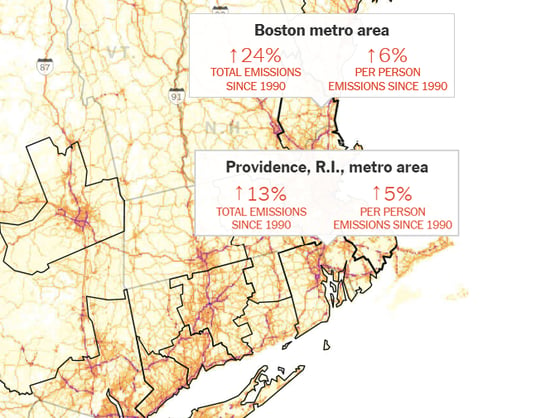I Want to Buy an Electric Vehicle Part 5: The Decision
Our new car is a Chevy Volt!
This past Friday, the Chretien family traded in our fabulous 2002 Toyota Prius and...
People who have known our organization for a long time are aware that our specialty was on home energy. That’s still a priority for us, but in recent years we have discovered that sometimes consumers actually leave their homes and consume energy! And that costs money and causes emissions of stuff that make for big problems. So in 2016, we launched our Drive Green program to help people make the switch from gasoline to electric cars. Today, we are building on our experience with Drive Green to advocate for electrified transportation, especially buses.
If you’ve read our website, including our blogs, you know why we’re doing all this. But if you haven’t been convinced yet to share our agenda, please take a look at these incredible data points.
Greenhouse gas emissions in Boston and Providence metro areas have gone up a lot!
As published in the New York Times on October 10, transportation emissions have gone up 24% in Boston and 13% in Providence since 1990. Emissions have gone up more than population. Per capita, emissions have gone up 6% in Boston and 5% in Providence.

We thank the researchers at Boston University who have provided this information with the most detailed map of auto emissions in the U.S. If you look for this kind of data on websites managed by either the state of Massachusetts or Rhode Island, you won’t find it. And that’s pathetic given that both states aspire to reducing greenhouse gas emissions 80% by 2050. The states have a pretty good understanding of emissions from electricity generation and are achieving results for the power sector, but when it comes to reducing emissions from transportation, the wheels have fallen off.
The research from Boston University focused on greenhouse gas emissions. But of course the vehicles were emitting other pollutants, the kinds that cause serious public health consequences.
Why this is happening is clear. At a time when the population has grown, we’ve allowed public transportation to fail. Look at this data on MBTA ridership, courtesy of WCVB’s excellent story, “The State of Gridlock: How do we get ourselves out of this traffic mess?”.

Obviously people are getting to work somehow. Again, courtesy of WCVB:

The number of registered vehicles in Massachusetts has increased by nearly a million since 2010.
If all those new cars were running on electricity rather than gasoline or diesel, emissions would be better. But both Massachusetts and Rhode Island are failing to meet their own goals for the adoption of electric vehicles by 2025 Massachusetts has a goal of 300,000 and we’ve got about 20,000. Rhode Island has a goal of 43,000 and it has about 1000. 2019 has not been a good year for EV sales in either state.
But regardless of how the cars are propelled, when we have that many more on the road, we are going to get awful congestion.
So whether you are concerned about the planet, your lungs, or your commute, all this data is evidence that we’ve set lofty goals for transportation and have landed flat on our faces.
You’ll be hearing from us more on this topic in the weeks ahead. But take a few minutes and think what this data means on your way to work. And question authority when you are told that steps are being taken to solve these problems.
This past Friday, the Chretien family traded in our fabulous 2002 Toyota Prius and...
In recent weeks, policymakers in Massachusetts and Rhode Island have taken actions that will affect the states’...
Comments